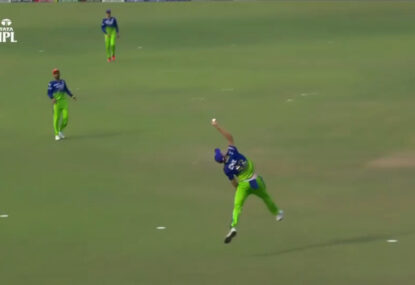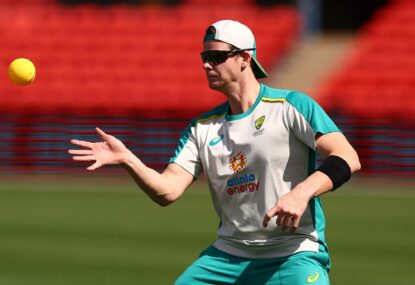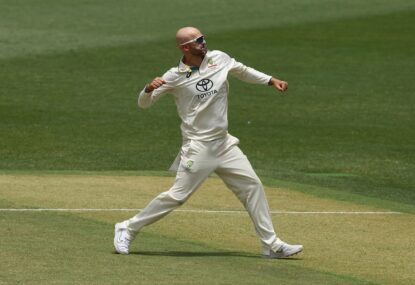One game into Australia’s T20 World Cup defence, and they are already facing a must-win match against England on Friday night at the MCG.
Following Saturday evening’s crushing 89-run loss to New Zealand, another defeat to Jos Buttler’s men would almost certainly see them miss the semi-final stage.
The reason? In a six-team group where only two advance, losing to the other two strongest countries is essentially a ticket home. Or, in this case, Australia’s ticket out of the tournament.
If Australia gets beaten by England, they will rely on one of Ireland or Sri Lanka upsetting the Poms, among other results. Yes, upsets do happen. But Sri Lanka is not a threat in these conditions and Ireland barely more than a competitive minnow.
Suddenly Australia’s dreams of back-to-back glory are teetering on the brink. Yes, they have four more matches to get things right. But if they go 0-2, the next three will probably be dead rubbers.
That is the ruthless nature of the T20 World Cup structure, made even more brutal when you consider how volatile the format is at the best of times within the games themselves.
Last year Australia, England and South Africa all won four group games, but the Proteas failed to progress due to net run rate. Australia’s manner of defeat at the SCG was almost as significant as the loss itself.
Always honest, Aussie skipper Finch shared a similar sentiment post-match when he faced the media.
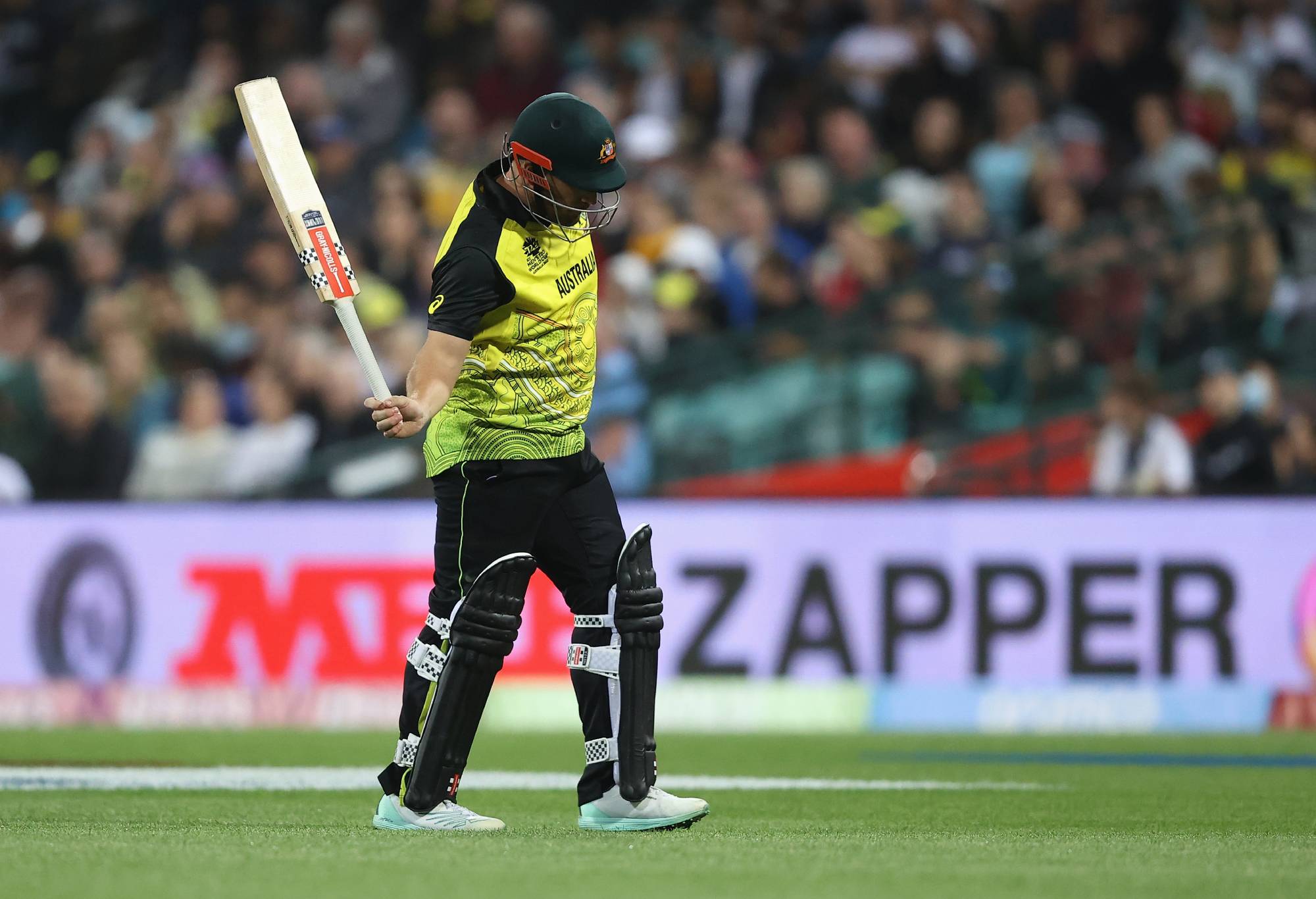
(Photo by Mark Kolbe/Getty Images)
“That’s a big loss in the context of the tournament,” Finch said.
“So yeah, it hurts our net run rate… I think we still back ourselves that we can win four games.”
It was New Zealand’s first win in Australia in any format since 2011.
Did Australia get their bowling tactics wrong?
Adam Zampa and coach Andrew McDonald were at odds over Australia’s tactics with the ball.
While McDonald felt the plans were suitable, Zampa felt Australia may have erred by not bowling Glenn Maxwell or taking more pace off the ball early in New Zealand’s innings.
The Black Caps’ win was set up in the PowerPlays on Saturday, as Finn Allen and Devon Conway helped New Zealand take 1-65 from their opening six overs.
The hosts did not bowl one over of spin in the PowerPlay, with Marcus Stoinis the off-pace option at the SCG.
In reply, Australia were 3-37 at the same point as New Zealand’s quicks made a point to bowl off-cutters early, with Tim Southee noting it had come on the advice of the team’s batters.
Spinners Mitchell Santner and Ish Sodhi took four wickets between them, while Zampa was Australia’s only spinner used.
“New Zealand probably used the facilities a lot better than we did. We possibly took a little too long to take the pace off the ball,” Zampa said after the crushing defeat.
“When I talk about making the right decisions early, it’s do we take the pace off in the second over or third or fourth over just to change it up a bit?
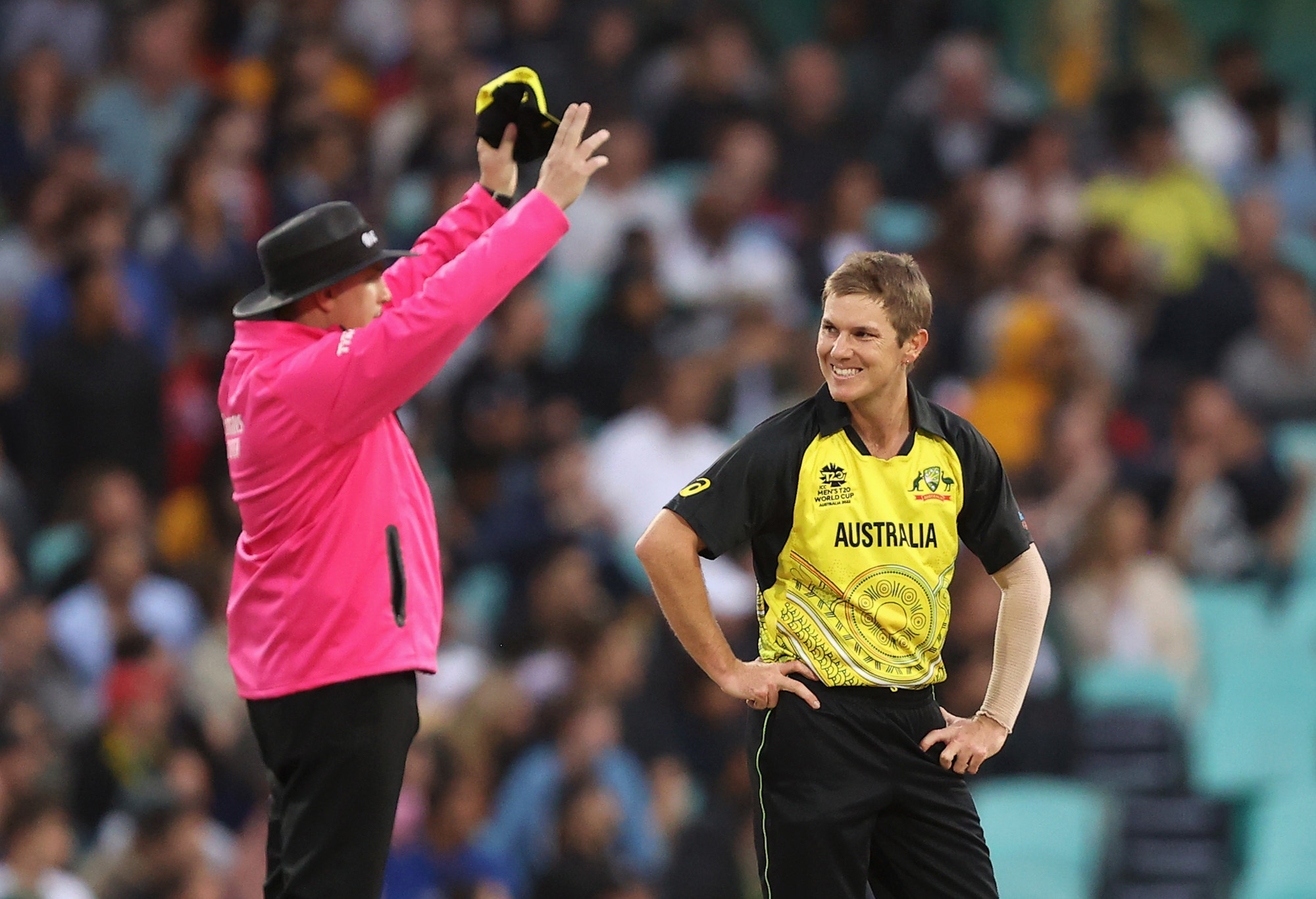
Adam Zampa reacts during Australia’s T20 World Cup match against New Zealand. (Photo by Mark Kolbe/Getty Images)
“Possibly, Maxi [Maxwell] would have been a great option.
“It felt like something needed to change. On reflection from everyone, even the quicks in the PowerPlay should have taken pace off more.
“Even I should have put my hand up and said I’ll bowl one in the PowerPlay.”
Australia’s captain Aaron Finch said after the match Maxwell was not bowled in the interest of match-ups, with Devon Conway, who batted through the innings, a good player of off-spin.
Australia must weigh up whether to stick with the same bowling attack for Sri Lanka on Tuesday in Perth, or bring in Ashton Agar as a second frontline spinner.
“Ash is always a great option for us, Maxi is a great option for us as well,” Zampa said.
“We made some poor decisions and it took us a little longer to assess the conditions.
“Once a team is 55 after four overs with 10 wickets in the hand, you’re chasing 180 if you can really claw it back, or 200-plus even if you have an okay back-end.”
McDonald defended the use of bowlers, pointing out that Stoinis was brought on in the fourth over.
“Hindsight is a wonderful thing. I think Marcus Stoinis was probably our first shift to pace-off,” McDonald said.
“It could have been a spinner at that point in time or Marcus Stoinis.
“After three overs, whether it was too late? That’s probably a long bow.
“Pat Cummins bowled a few slower balls out as well. Finn put us under great pressure, and Devon Conway, that was a great innings.”
Finn Allen, welcome!
The 23-year-old Allen didn’t just keep Martin Guptill out of New Zealand’s XI: he attacked the Australian new ball with complete disregard for who they were and what they have achieved.
Let’s be clear: there is no better PowerPlay batter in the world than Allen. He has the greatest strike rate in those crucial opening overs in T20 history, hitting at a jaw-dropping 162 runs per 100 balls. He’s a weapon of mass destruction at the top of the order, and this could be his breakout game on the grandest stage.
His 42 from 16 balls allowed New Zealand to get off to a flyer. After three overs, Allen was on 35 himself. By the time of his dismissal in the fourth over, his team was on 56. Ooft, what a platform.
Eventually Josh Hazlewood undid him with a classic yorker, but by then the SCG crowd was well and truly aware of who Allen was and what he could offer this New Zealand team.
Allen has already gained attention abroad, both in the IPL and England. His modest first-class batting average of 20 from 16 games suggests he will favour the white-ball formats.
He has played one-dayers for New Zealand. But this turbocharged method is like Brendon McCullum on steroids and further proof that the T20 game does not sit still. His career strike rate in the format is nudging 170.
It’s also worth noting that the last time New Zealand faced Australia in a World Cup game on these shores, Mitchell Starc rattled McCullum’s stumps in the first over. On Saturday night, Starc’s first six deliveries went for 14. How things can change.
The curious cases of Smith and Williamson
Two modern-day greats are facing uncertain T20 futures. What side of the fence do you sit on?
Was Williamson’s innings of 23 from 23 deliveries a) the perfect foil for Devon Conway (92 not out from 58 balls) and platform for Jimmy Neesham? Or, b) yet another sign the captain is lucky to be in the New Zealand team?
This calendar year, Williamson has scored at barely one run per ball in T20 international cricket. His output has dropped significantly, but even with his knock, the Kiwis still scored 200.
Consider that, then have a think about Smith, who carried the drinks at the SCG and is the spare specialist batter in the Aussie setup. What must he think to see Williamson trusted to play a specific, steadying role for New Zealand while his big-hitting Aussie teammates crumble in front of him?
CLICK HERE for a seven-day free trial to watch cricket on KAYO
Smith is like Williamson, maybe even better. But Williamson has been trusted to adapt – that’s the difference.
Australia’s middle order is jam-packed with huge hitters. Glenn Maxwell mostly tried it left-handed on Saturday night, Marcus Stoinis is brute force, and Tim David treats cricket like the driving range.
At the top, Aaron Finch, David Warner and Mitch Marsh are all potential match-winners, but have very little nuance or craft. (This may be harsh on Warner, who has developed this component of his game significantly in recent years.)
Broadly, it’s not their natural style to anchor an innings. But it is Smith’s. He can control things, manipulate a chase, and accelerate adequately – albeit not explosively – if required.
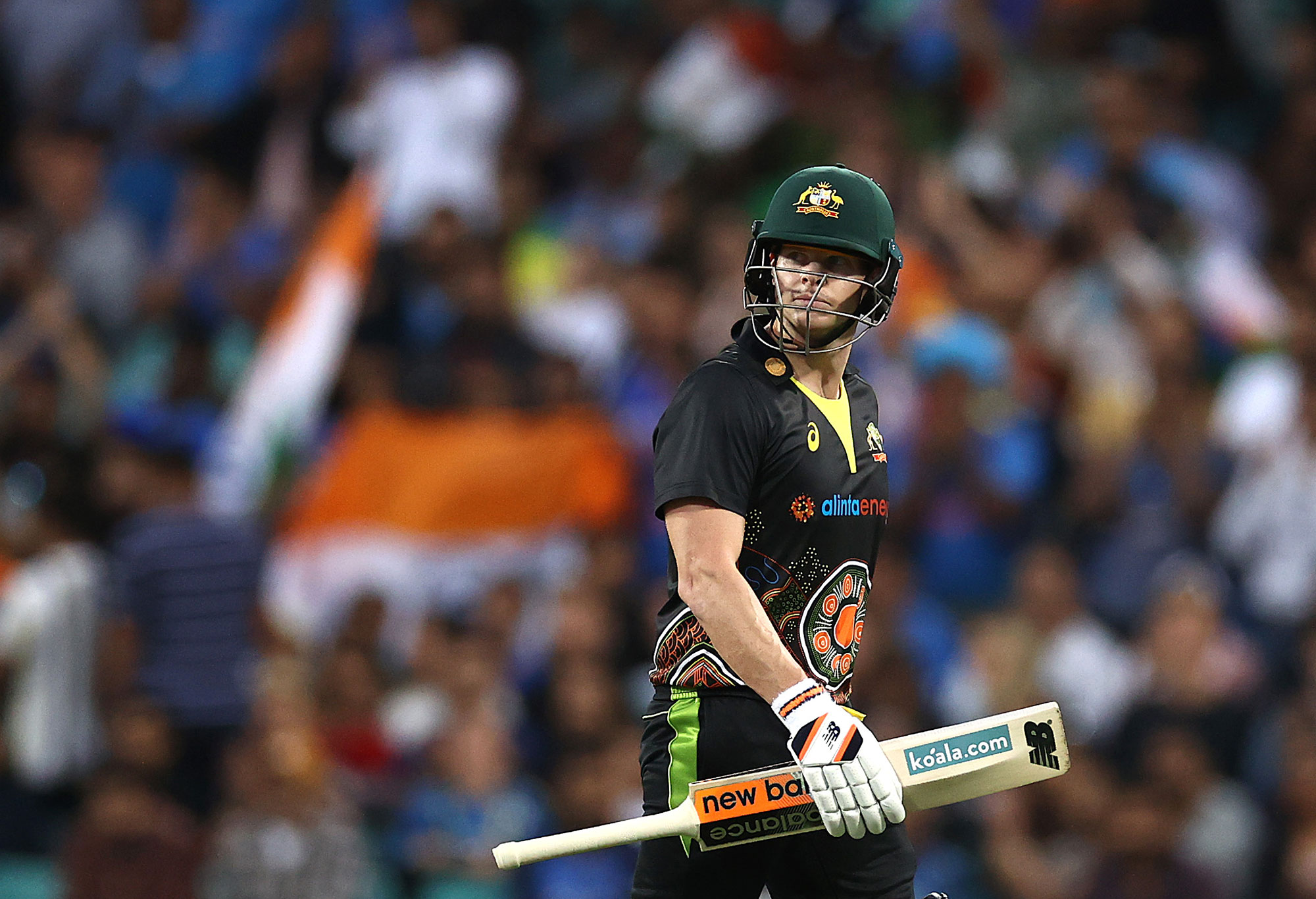
(Photo by Ryan Pierse/Getty Images)
Would Australia have chased down 201 with Smith playing? Unlikely. Across the past few games and Saturday night’s loss, does Australia appear slightly one-paced and one-dimensional in its middle order? Yes.
“Tonight Smith would have been really handy,” former Aussie seamer and NSW teammate of Smith Trent Copeland said on SEN.
As it has been for 18 months, the elephant in the room is still Aaron Finch’s form, though it appears almost academic writing or talking about it. He’s the captain and he won’t drop himself.
Maxwell averages 8.7 across his last 10 T20 knocks for Australia, Stoinis has only just returned from injury, and David is a newcomer at the international level. The middle order is not firing, Finch is limping to the finish line, and it is unfair to leave everything to Warner and Wade.
The batters could also rightly argue it was not them who leaked 200 runs from 20 overs on Saturday night. Chasing a score of that magnitude is never easy, but the batting performance was nevertheless poor.
Australia must decide quickly whether Saturday night’s loss was an aberration and the current XI is worth persisting with, or more radically determine they have prepared incorrectly and need a slight re-shuffle. After all, what are squads for?
Shane Watson said on the official broadcast that Australia must stick to their plans. If they do and it fails, they will be accused of being stubborn. If they change things and it fails, they will be called reactionary.
And a final thought…
It’s only early days, but surely we have a catch of the tournament clubhouse leader that will not be bettered.
Glenn Phillips leapt high into the night sky to pull off a screamer that would rival any outfield catch in the history of the game.
“It could be one of the greats of all time,” Copeland said on SEN.
“It brought back memories of Glenn McGrath in Adelaide, in fast forward really. At full length, almost two metres off the ground. It was an exceptional catch.”
For Phillips, this was not a once-off, as English journalist Will Macpherson tweeted. The Black Cap is renowned as one of the best outfielders in world cricket – and it just so happens that he is also a gun wicketkeeper.
His catch was the cherry on top of a superb evening for New Zealand. Even evergreen quick Tim Southee did his thing, capturing 3-6 with the ball.
New Zealand, as Michael Vaughan tweeted, always show up for World Cups.



































































































